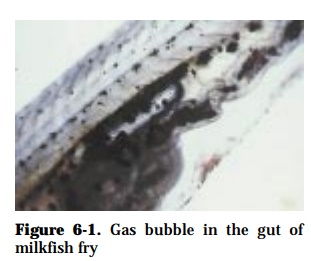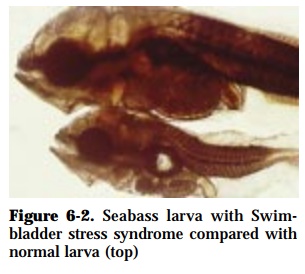Chapter: Health Management in Aquaculture: Environmental and other non-infectious diseases
Fish Diseases Associated With Physico-Chemical Properties of Water
FISH DISEASES ASSOCIATED WITH PHYSICO-CHEMICAL PROPERTIES OF WATER
Gas Bubble Disease
Gas bubble disease is due to supersaturation of dissolved gases (nitrogen oroxygen); supersaturation may be due to leaks in pump or valve systems in hatcheries; dense algal bloom that presumably caused oxygen depletion at night and supersaturation during the day.
SIGNS:
Affected fish show bubbles in the abdominal cavity, eyes, skin, gills, fins, mouth, swimbladder and within the digestive tract (Fig. 6-1) and exopthalmia. The clinical signs of gas bubble disease should not be confused with Swimbladder stress syndrome because the bubbles in the latter can be seenonly in the swimbladder.

EFFECTS ON HOST:
Death due to embolism in blood and emphysema in tissues; edema and degeneration of the gill lamellae; bulging of the cornea; abrupt mass mortali-ties.
PREVENTION AND CONTROL
• Monitor dissolved oxygen (DO)
• Avoid algal blooms
• Maintain efficient operation of waterlines and pumps
• Sufficient water exchange
Swimbladder stress syndrome (SBSS) is associated with malfunction of theswimbladder and is also associated with a combination of handling, high am-bient temperature, high ambient illumination, dense algal bloom that presum-ably cause oxygen depletion at night and supersaturation during the day.
SIGNS:
Affected fish larvae show large bubble of gas in the region antero-dorsal to and outside the swimbladder (Fig. 6-2).

EFFECTS ON HOST:
Hyperinflation of swimbladder; high positive buoyancy and mass mortalities.
PREVENTION AND CONTROL:
• Filter rearing water
• Regulate algal bloom in hatcheries
• Provide strong aeration to maintain the larvae beneath the water surface in hatchery tanks
Asphyxiation/Hypoxia
Very low levels of dissolved oxygen (DO) cause asphyxiation/hypoxia.
SIGNS:
Affected fish gather at the water inlets and outlets. Also fish with wide gaping mouth swim at water surface and show rapid opercular movement.
PREVENTON AND CONTROL:
Monitor DO levels and provide aeration.
Salinity
Extremely high salinities are associated with progressive emaciation, scale loss, and opaque eye lenses in affected fish.
Alkalosis
Alkalosis comes about when water becomes too basic. The pH increases to a level higher than the fish can tolerate.
SIGNS:
Affected fish show corroded skin and gills and milky turbidity of the skin.
PREVENTION AND CONTROL:
Monitor pH level, and maintain the pH in a range optimal for the species being cultured.
Acidosis
Acidosis is caused by a drop in the pH to a level too low for the species.
SIGNS:
Affected fish show rapid swimming movements and gasping. Increased mucus secretion and death occur very quickly. Affected shrimp show poor growth, low molting frequency and yellow to orange to brown discoloration of the gill and appendage surfaces. The pond soil turns reddish in color.
EFFECTS ON HOST:
Normal metabolism is hindered resulting in retarded growth and eventual death.
PREVENTION AND CONTROL:
• Monitor pH
• Apply lime and flush pond bottom before stocking
Sunburn Disease
Sunburn disease is due to excessive levels of ultraviolet irradiation from sun-light when fish are stocked in shallow uncovered raceways under intense sun-light.
SIGNS:
Development of gray focal circular ulcerative lesions on top of the head, pecto-ral, dorsal and upper tail fins.
EFFECTS ON HOST:
Ulcerative lesions may serve as portals of entry for other pathogens and may result in secondary infection.
PREVENTION AND CONTROL:
Place sunshades over ponds, and fish should be kept away from ultraviolet installations.
Related Topics